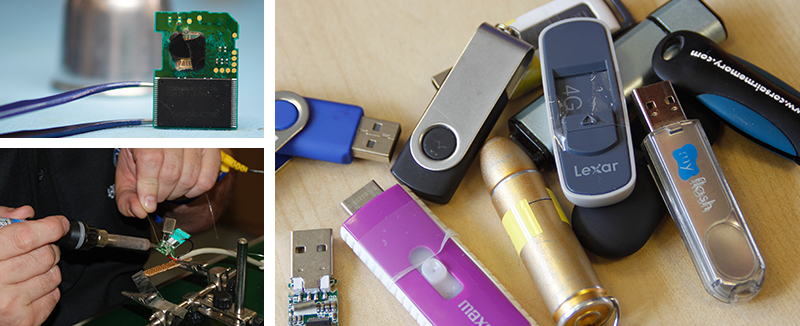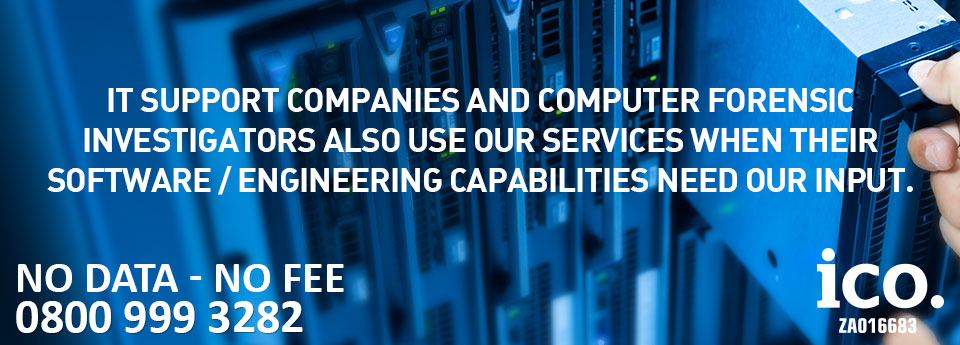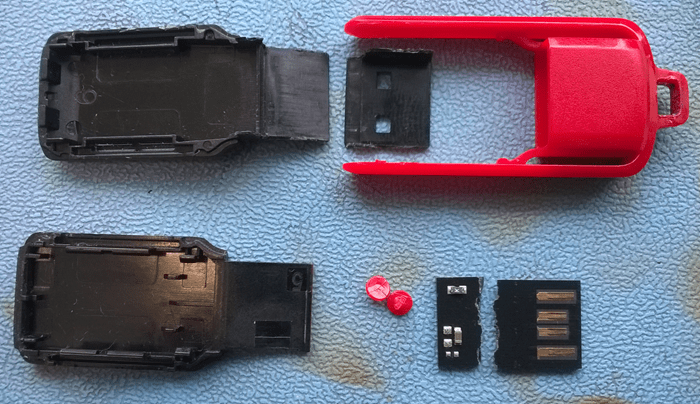USB Pen Drive Data Recovery
Memory stick recovery, broken memory stick repair and recovery of failed USB flash drives by R3 Data Recovery. We also recover files from media that has been accidentally formatted.
Using the very latest technology and recovery techniques we rescue data from every conceivable problem no matter what system your External Drive was connected to.
Operating Systems Windows, Apple MAC, Linux, Unix.
- Digital Cameras - SD, Compact Flash, XD, Memory Stick, Plus Many More
- Digital Camcorders - SD, Compact Flash, Memory Stick, SxS, Plus Many More
- Mobile Telephones - iPhone, Blackberry, Palm Device, Smart Phone
- Mobile Storage - USB Pen Drive
At R3 Data Recovery we have the ability to recover your precious data from many different scenarios. Whether you have accidentally deleted files from your device, dropped it, or even if the computer fails to recognise the device when attached, we have a solution for you. Our expertise in the recovery of solid state devices is unrivalled in the UK.
We are one of the few labs in the UK that can remove your storage chip and recover your data when your flash memory has completely failed.

There are many ways your USB Flash Memory can fail.
- Physical - Bent, Snapped or Damaged Connectors
- Logical - Deleted Data or Formatted Flash Memory
- Electronic - Power Surges, Device Not Recognised
- Bad Luck - Just Stopped Working, Dropped In Toilet, Chewed By a Dog, etc
USB Device Not Recognised
Possibly up to 85% of all failures of all flash media appears to be when one minute your device is working perfectly - the next time you look the device either seems to lock up on you in mid use or appears completely dead! The device will be inserted into the USB port or card reader and you will either get:
- "USB Device not recognised"
- "Your device requires formatting"
- Your device appears completely dead
- Your device shows up as either "full" or "empty"
The cause of this message is nearly always the failure of the "controller" - a small chip that lies on the internal board. This chip is extremely important and it writes data to the device from the PC or laptop, and also allows access to the internal storage chip (NAND).
Most people will assume that the device is in some way faulty and try to run software and will often download a programme from the internet. Unfortunately this is no help at all as the data chip, which is separate to the controller, is very often intact but unreachable due to the failure of this controller.
In these circumstances the only way to recover the data is to simply send the device to us as we have exclusive technology that allows us to read data from these chips.
Don't attempt to repair the device yourself, you simply cause more damage and run the risk of a non recovery. If you value the data on the device you will use a data recovery professional such as ourselves. Ring us on 0800 999 3282 to discuss your data recovery needs.
Broken USB Memory Stick
The second most common form of failure of a USB memory stick is when the device gets either bent, or the connector broken off. This is all to often a result of someone either dropping a laptop with the memory stick still inserted, or if the device is plugged into a desktop - knocking against it as you walk past.
If this should happen then you have an extremely high chance of getting your data back, statistically about 98-99%. Our skilled technicians can either repair the device or gain access to the chips on the internal board by fine rewiring and bypassing of the broken connectors.
In our opinion it is NOT worth attempting a repair yourself, very often people have rendered the repair process impossible by using the incorrect amount of solder or simply not having the required skills to complete the repair successfully. Our own electronics team recover devices like this all the time and have the expertise and tools to ensure your valuable data is recovered.

USB Sticks are becoming a more popular means of keeping important data on yourself at all times, they are small and very portable and can be attached to car keys, hand bags, purses etc. However with them becoming more popular, companies are trying to find more ways of reducing production costs but at the same time attempting to generate more stock.
This is good for the company as they are producing more products at a lesser cost and selling them at the same cost price. Consequently this is bad for consumers that use them as the quality of the product is becoming worse as the demand increases.
Companies are using cheaply manufactured controller chips and In some cases including what we have seen here at R3 the NAND chip is actually a re-used SD card that has been soldered onto the PCB to act as a NAND chip to again cut costs for the company manufacturing the storage device.
Less time is also spent soldering on these cheaply manufactured devices so they are more prone to failure than normal as they have not been manufactured in the correct method. At R3 we have to reverse engineer the device so we can work out how the device works and if we can recover the data.
The demand for these devices is ever increasing, and the fact that some companies are trying to cut the cost of the production for these devices to increase their profit is going to end up with more of them failing and people potentially losing critical data.
Our recommendation would be to back up any storage device to another storage device and place this device somewhere safe and not use it unless needed.

Don't Risk Losing All Your Important Data
It is so important that you contact us so we can help diagnose the best and cheapest way forward. If you try to recover the data yourself you may cause further damage depending on the issue, which is why it is important you contact us as early as possible.
We provide outstanding customer support and continually update you as to the current status of your recovery.
We are not a reseller; you will talk to the technician who is performing your recovery!
If you have a failed or failing USB Stick or any flash device for that matter get advice and assistance from Andy and the team at R3. R3 Data Recovery is real lab that deals with real disasters each an every day. If you have any sort of problem with a USB flash drive or any other data storage device, we are the people to contact.
Call us today on 0800 999 3282 or click here to fill out our FREE, no-obligation diagnositcs form for immediate help and assistance.
Large Capacity Devices - The Dangers Of These
Water Damaged Device Still Recoverable
Wear Levelling
Encrypted Controllers
When do I use a Data Recovery Software?
Physically Damaged monolith
Whilst it may seem very attractive to have large storage potential on a flash device (particularly one you can carry) there are dangers associated with storing so much data on a USB memory Stick.
Firstly, recovering such a device will prove complex. Current NAND reading technology is always having to keep pace with increasing storage capacities. In some cases recovering 32GB and 64GB devices can prove extremely difficult, so one can imagine the issues associated with a device of 256GB! This is also going to impact the recovery costs.
Realistically recovering a small capacity device isn't likely to take too long, we allow a standard 5-7 days for our service but we often are able to recover them in a far shorter time period. We can't however give any such indication of how long it might take to recover a 256GB device. For a start the device is likely to have 16 16GB Flash NAND chips in the internal PCB. Reading the RAW data will take many hours - even days - and this is before we have begun to decode the complex algorithms!
Anyone who offers a flash device recovery, particularly one who offers a recovery from 30 or 40 pounds will have no chance at recovering one of these. We know how long and how much effort it will take to recover this type of device and a fee of several hundred pounds will be in order.
Our advice would therefore be that, for now, steer clear of these as should you use one and it fails a recovery fee of several hundred, possibly even thousand pounds will be in order. R3 Data Recovery always try to offer cost effective recovery from portable flash storage media but in this case the fees are more than likely going to price the recovery beyond the reach of many of us.
Most of us would think that when our flash media device, such as a USB memory stick or an SD card becomes immersed in water that the likelihood is that the device is likely to never work again and the information on it, if not backed up, will be lost forever.
We are delighted to disprove that myth with recent recoveries of devices that have been either sent through the washing machine or even indulged in a spot of surfing. In most cases the internal chips on a flash media device will not actually be damaged by a trip in the soup, only the board on which they are placed. Once the internal Flash NAND chips are removed from the board and read via external readers the data is normally recoverable. One recent case indicates that your precious data is not always lost in the soap suds.
This such case involved an author who was keeping his book on his memory stick. For safe keeping he placed the device in his shirt pocket to ensure he would lose it. Of course, the next day his shirt was washed along with his device. Despite the fact that the internal board on which the chips are placed did suffer from corrosion and failed owing to exclusive technology the data was not lost at all.
Whilst the device itself was a write off the chips containing the data were not actually damaged by the water. After being read through a chip reader and then the algorithms were reconfigured meaning that the data (his book) was fully restored leading to a grateful customer whose only copy of his book was on the device.
Therefore if your device has had a trip in the sea or the washing machine -DON'T BIN IT - without at least sending to us first!
The moment you first use a flash drive it will have a limited number of times that data can be written to it. Typically this finite number of read cycles will be a lot (up to perhaps 100,000) however it does mean that, despite what many people think, a solid state device is not going to last forever.
With this in mind you are well advised to NOT rely on a single flash drive as a sole storage for critical data. The policy should always be to keep multiple backups for data that is irreplaceable.
One method of prolonging the lives of these devices is a process called wear levelling where the device will allocate the data chunks evenly over the entire device. This ensures that one particular zone of the Flash NAND chip doesn't get ordinarily worn by having data continuously written to it. If a device only has a few files on it and these were consistently written to the same zone then the chances of likely failure is increased.
As a process Wear Levelling works by the "controller chip" allocating the data to the Flash NAND chip either statically or dynamically.
The purpose of this article isn't to go into too much detail about wear levelling, more to warn users of these extremely handy devices not to rely on them as unlikely to fail. Like any manufactured device, despite any inbuilt systems to negate failure, they can and will fail at some point in the future. The secret is for you to have decommissioned the device before it fails on you causing stress and data loss.
If the device does fail then the chances of a successful recovery are extremely good, but as they say prevention is better than cure.
In recent months we have received numerous requests to help recover data from devices that have turned out to have encryption on them.
In the past scandals involving data loss (most memorably from a government dept which sent out data burned onto an unencrypted CD) have meant that the tightening of organisations data transfer and data handling policies. This invariably means that executives in the NHS, for example, will use either a device with a secure U3 Utility on them or a device with some other inbuilt data encryption system.
There is also the added issue of a major brand - SanDisk(pictured) that, by default, have controller chips that encrypt the data as it is written onto the Flash NAND.
Whilst this makes the device secure both of these will cause complications in the recovery process as the encrypted data can't be decoded into a useable format for the individual whom has suffered from the data loss. Whilst no-one may expect to lose their data through a faulty device it is all too common for a USB memory stick and other flash based media to fail - totally unexpectedly.
If the device has PCB component failure or a bent / damaged connector then the chances of a successful recovery outcome are extremely high 95% or better.
Most users will not be aware of this encryption issue until it is too late! By that we mean that the device will have failed with the user unable to access the data on a device that is encrypted and in all probability unrecoverable.
Therefore our recommendation is that you always maintain a dual system of backup for portable storage media such as a USB Memory Stick. That way if one device does fail you revert to backup No2!
Many people will often misunderstand when to use software when attempting to recover data / images from a failed memory stick or SD card. Whilst there is never a golden rule the following information may assist people in coming to the right decision.
Failed flash media will often give the following error message - "Your device requires formatting". This often gives rise to the assumption that the faulty card will be recoverable by software as the user will think the card has been formatted. Software of course is often employed to recover cards and other flash media that has been formatted either accidentally or deliberately.
However in the example quoted above software is not suitable as the card will actually have a faulty / failed controller chip and this will mean that the device will not respond in any way to software being run on the device.
If you get this error message then the only option for a recovery will be the removal and decoding of the internal Flash NAND chip. Do not consider using software, particularly if the software isn't offered a free trial basis first. Whilst running software won't do the chip any harm it would be an unnecessary expense should the software have to be paid prior to downloading and running on the card.
So to conclude - our advice is - only run software if you know that data or images have been deleted either by intent or accident. In doing so please consider the length of time that has elapsed since the data was deleted and if images or data have been written to the card / device subsequent to this happening, as this can have a bearing on the chances of a successful recovery from the device. The general rule is the longer that has elapsed since the act of deleting the less likely a full and useable recovery is.
A recent arrival at R3 Data Recovery was a USB stick SanDisk CruzerSwitch that had been accidently kicked whilst plugged into a computer. The connector had been bent away from the rest of the circuit board and because the internal construction type was monolith nothing could be done for the client.
If a monolith is physically damaged in anyway there is no method of retrieving the data as the actually memory where the data is stored is damaged. However, if a non-monolithic USB is physically damaged there is chance that the data is recoverable depending on what part of the USB stick is damaged. If the PCB (Printed Circuit Board) is damaged there is always the chance that the data is recoverable either by soldering or what we refer to as a NAND read. However, if the NAND chip itself which is where the data is stored is physically damaged, recovery is impossible.

